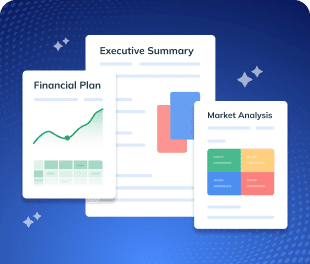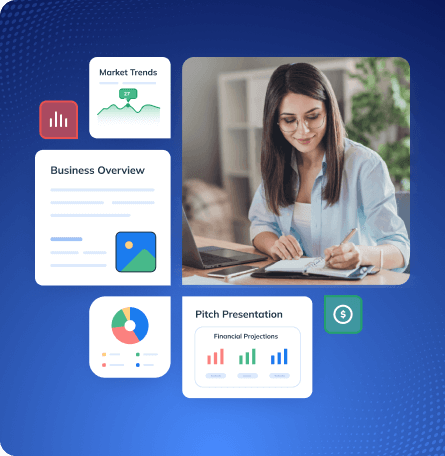Love golf? Good. Want to turn it into a real business? Even better!
Indoor golf simulators are booming, and it’s no surprise. People want a place to play year-round with zero weather worries and flexible tee bookings that fit their schedule.
But great swings don’t guarantee great profits. If you want this to work, you’ll need a solid business plan that helps you map out how the whole thing will actually work—where the money comes from, how you’ll attract customers, and what sets you apart.
Wondering how to create a plan?
Don’t stress! This golf simulator business plan template walks you through every step, without overcomplicating anything.
What is a golf simulator business plan?
A golf simulator business plan is a detailed document that explains how your indoor golf venture will run and make money. It outlines your business concept, services, location, customer base, pricing, daily operations, and financial expectations.
Whether you want to open a solo setup or a large indoor golf center, it helps you stay organized, avoid costly mistakes, and attract funding.
→ Download Now: Free Golf Simulator Business Plan
Key elements included in a golf simulator business plan
Let’s break down the key components your plan should include, with a quick explanation of what each one does.
- Executive Summary: Provides a brief overview of your concept, goals, services, audience, and financial snapshot.
- Company Overview: Explains your business model, legal structure, location, and what sets your setup apart.
- Market Research: Covers local demand, target audience, industry trends, and potential market gaps.
- Competitive Analysis: Identifies local competitors and highlights how your business will offer something better or different.
- Services Offered: Lists key revenue streams like rentals, memberships, events, coaching, and optional add-ons.
- Sales and Marketing Strategy: Shows how you’ll attract customers, promote your brand, and drive bookings and repeat visits.
- Management Team: Introduces the owners and key team members, along with their roles and relevant experience.
- Operations Plan: Explains your daily business flow—staffing, bookings, equipment care, and software you’ll use.
- Financial Plan: Breaks down startup costs, revenue projections, ongoing expenses, and funding needs.
How to write an effective golf simulator business plan?
Writing your business plan doesn’t have to be complicated. Start with the basics, stay focused, and build each section clearly.
Here’s how to write each part of your golf simulator business plan:
1. Executive Summary
The executive summary gives a high-level overview of your golf simulator business. Even though it comes first, it’s easier to write after finishing all other sections.
- Start by summarizing the business idea: What you’re offering (e.g., indoor golf lounge or training studio), location, target audience, and your primary goals.
- Highlight key services like simulator rental, private events, memberships, and golf coaching. Also, explain how you’ll stand out from competitors.
- Mention startup costs, ongoing expenses, and expected revenue or profitability within the first year or two. If you need funding, briefly say how much and what it’s for.
Say goodbye to boring templates
Build your business plan faster and easier with AI
Plans starting from $14/month

2. Company Overview
This section introduces your business structure and concept in a bit more depth. It explains your “why,” your setup, and how your business fits in your local scene.
- Outline your business name, legal structure (LLC, sole proprietorship, etc.), and ownership structure. Also, cover the type of simulator space you’re building.
- Explain location details, size of the space, number of simulator bays, and any added areas (lounge, snack bar). Share your mission, vision, and business values—like affordability, accessibility, or premium experience.
- Share your background story—why you chose this niche and how your background (if relevant) helps you run the business.
3. Market Research
Here, show that you’ve done your homework. Explain who your customers are, what the market looks like, and how your business fits in.
- Include market stats—growth of indoor golf businesses globally, local population with disposable income, and year-round indoor demand. Mention key trends in indoor sports and tech-based experiences as well.
- Identify and define your target audiences: casual golfers, students, corporate groups, or pros needing off-season practice.
- List age groups, interests, income levels, and playing habits of your ideal customer groups. If required, create a detailed customer persona to better understand their needs.
4. Competitive Analysis
In this section, assess other local businesses, and demonstrate you’ve sized up the competition and know how to stand out.
- Identify other indoor golf venues nearby—what do they offer, how much do they charge, and who do they serve? Study how they operate and their customer feedback.
- List indirect competitors too (driving ranges, country clubs, sports bars). Point out weaknesses in their business models (tech, space, experience, support) and clarify how your business will be different or better.
- Explain your competitive edge, such as a better booking system, flexible pricing, high-end tech, events calendar, or stronger customer service.
5. Services Offered
This part lists every service your business will provide and explains how each one generates revenue. Be thorough—how it meets customer needs, and how each service makes money.
- Outline core services: hourly simulator rentals, coaching, practice sessions, tournaments, and swing analytics. List secondary services, like food, drinks, retail items, and memberships.
- For each service, explain the value it brings to customers. Clarify how pricing will vary based on time, day, or add-ons.
- Jot down what makes your offer better or your unique value: multi-sport simulators, realistic course environments, mobile booking, exclusive membership perks, or streaming sports on simulator screens.
6. Sales and Marketing Strategy
This section outlines how you’ll promote your golf simulator business, gain new customers, and build loyalty. It should cover both your launch strategy and your long-term plan to keep traffic steady.
- Outline the marketing channels you’ll focus on: SEO, social media, Google listings, local sponsorships, or PR. Mention promotional tactics such as soft launch events or loyalty programs.
- Describe your customer acquisition strategy (e.g., introductory offers, referral perks, or collaborations) as well as highlight your retention strategy (e.g., membership plans or email follow-ups).
- Clarify your marketing budget and how it’s allocated between platforms or campaigns. Don’t forget to share branding approach: fun and casual vs. premium and pro-focused—whatever fits your audience
7. Management team
Here’s where you introduce the people behind the business. Whether it’s just you at the start or a small founding crew, highlight what they bring to the table and who’s handling what.
- Introduce yourself and any co-founders with relevant experience in sports, hospitality, customer service, or tech. Then, define who handles what: day-to-day operations, marketing, finances, or customer support.
- If you don’t have a full team yet, list key roles you plan to hire first (e.g., shift manager, trainer, tech support, or front-desk staff) and how you’ll find and train them.
- Add any advisors, mentors, or consultants who will help with strategy or finance. If applicable, build an organization chart to show your team structure.
8. Operations plan
The operations plan section outlines how the business will function on a daily and weekly basis. It covers everything, from bookings to maintenance and customer service procedures. So, keep it practical.
- Describe your hours of operation and seasonal variations, if any. Define staff responsibilities, shift coverage, and scheduling method. Then, outline how simulator bays are booked, monitored, and reset between sessions.
- Share your cleaning checklist, simulator maintenance routines, and how you’ll handle tech hiccups quickly. Also, talk about how customers book—online, in person, or both—and how you’ll keep it all organized.
- Further, mention any tools or systems you’ll use to manage bookings, payments, and customer communication. This can make everything run smoother.
9. Financial plan
This is where you prove the business is financially sound. Show what you’ll spend, how you’ll earn, and how long it takes to turn a profit.
- Break down startup costs into categories: equipment, renovations, licenses, software, and working capital. List monthly expenses like rent, salaries, software subscriptions, maintenance, and marketing.
- Estimate monthly revenue based on expected usage and pricing for each service. Include 12-month and 3-year financial projections to show long-term stability. Define your break-even point and justify your assumptions
- If seeking funding, specify the exact amount, how it will be used, and what you’re offering in return (equity, repayment terms, etc.)
Key considerations for a golf simulator business
Before you start your golf simulator business, focus on the factors that will directly impact performance, customer experience, and profitability.
Here’s a simple breakdown of what to get right from day one:
- Location & space: Choose a location that’s easy to find, near busy areas, has good parking, and ceilings at least 10 feet high for full swings and sensors.
- Simulator technology: Go for commercial-grade simulators that track ball speed and direction well. Pick ones with good reviews, software that gets regular updates, and quick customer support.
- Licensing & insurance: Make sure you get all the required licenses and permits, especially if you serve food or alcohol. Also, protect your business with liability coverage and insurance.
- Seasonal demand: Expect more customers in winter or rainy seasons. Plan group packages, off-peak discounts, or mini tournaments to stay busy year-round.
- Layout & comfort: Set up your space so it’s roomy and easy to move around. Add comfy seats for guests, a check-in area, and maybe a small bar or snack zone.
- Target flexibility: Welcome all kinds of players—from serious golfers to casual groups—by offering lessons, leagues, and chill social sessions.
- Upkeep & support: Keep all gear clean and in top shape with regular maintenance. Keep spare parts handy and have tech support ready when needed.
- Community building: Create a strong local base by hosting weekly leagues, themed events, or member nights. These make people feel connected and keep them coming back.
Download a free golf simulator business plan template
Ready to draft your golf simulator business plan? But don’t want to start from scratch? We’ve got you covered. Download our free golf simulator business plan template in PDF format to get started.
This modern, investor-friendly business plan template includes pre-written sections, real examples, and prompts to help you speed up your planning process and avoid missing key sections. You can even customize a few parts to make it your own.
The Quickest Way to turn a Business Idea into a Business Plan
Fill-in-the-blanks and automatic financials make it easy.
Prepare your business plan in Upmetrics
After exploring the above step-by-step guide and a free template, it should be much easier for you to write a detailed indoor golf simulator business plan.
However, if you’re still feeling confused or overwhelmed by the details, consider using our AI-powered business planning software—Upmetrics. It helps you get investor-ready without any stress.
Upmetrics makes planning faster and easier with its advanced AI capabilities and built-in financial forecasting features. It’s perfect for golf entrepreneurs who want to hit the ground running.



